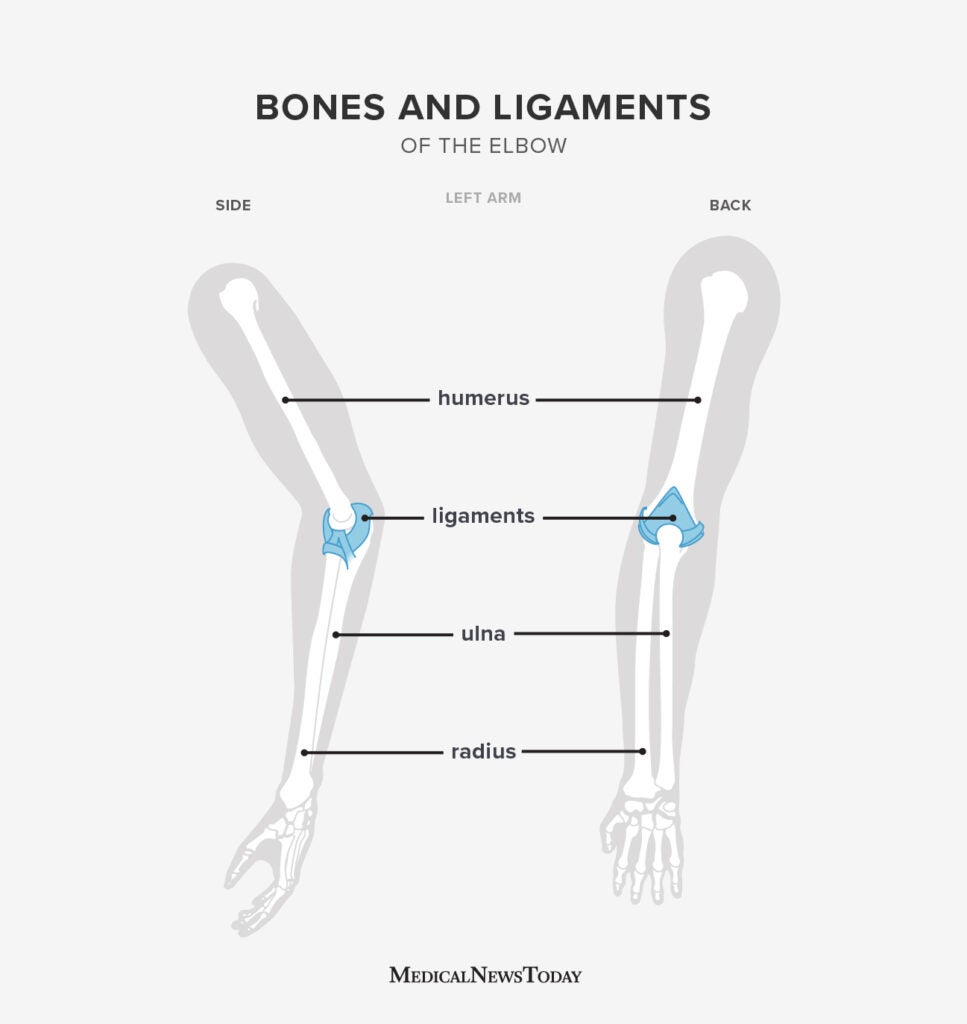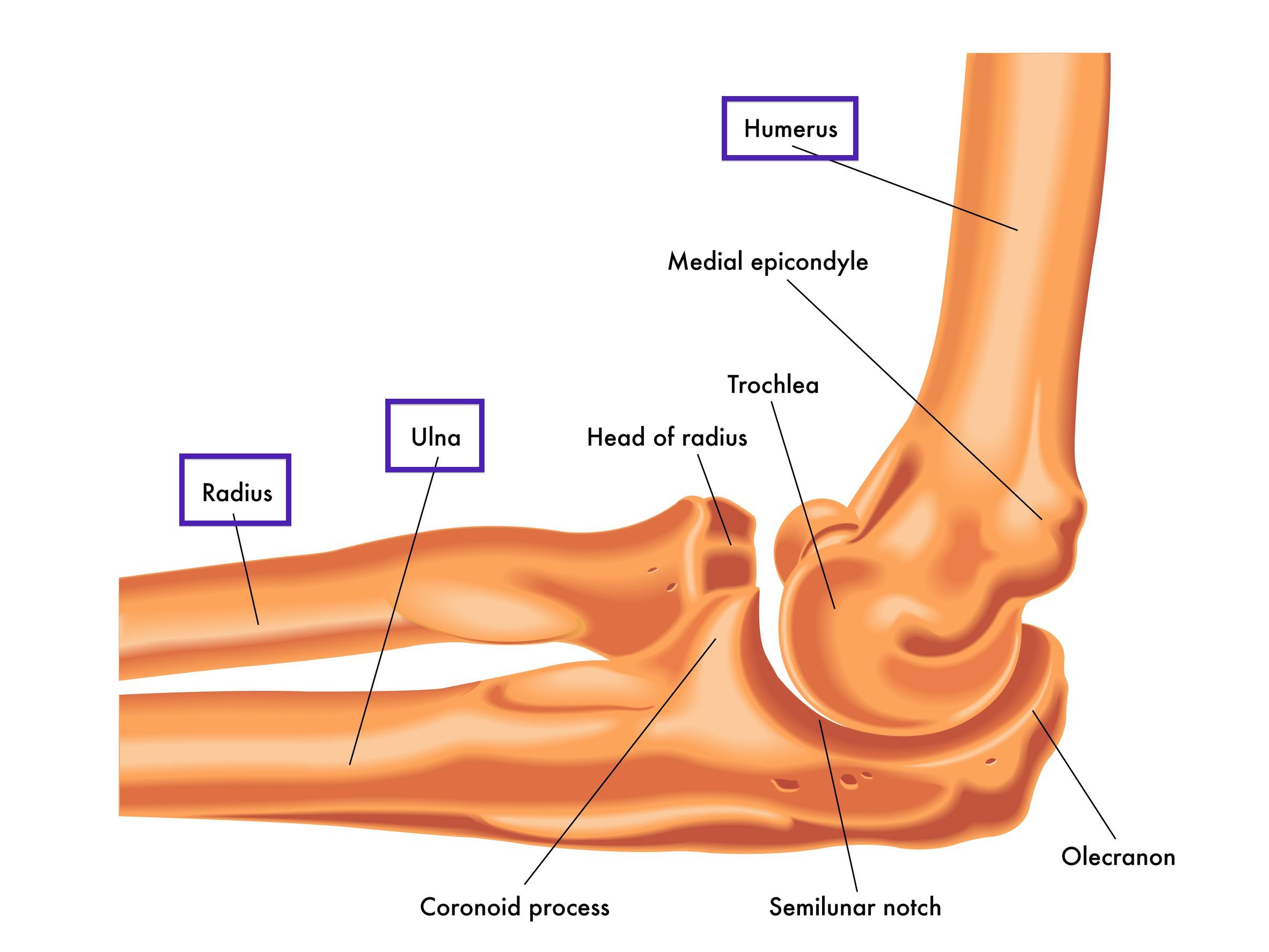What Bones Form The Elbow Joint
What Bones Form The Elbow Joint - Web the bones that create the elbow are: Web the functional anatomy of the elbow joint complex is unique in orientation and configuration. Three bones, the ulna, radius, and humerus, articulate to form four articulations: This forearm bone runs from the elbow to the thumb side of the wrist. The bones are held together with ligaments that form the joint capsule. The humerus (your upper arm bone). Here’s the joint with its loose capsule removed and its ligaments intact. Web your elbow joint is where three bones in your arm come together: The elbow is often thought of as being a single joint, but it’s actually made. The second forearm bone, running from the elbow to the side of the little finger joints and articulations in the elbow
The radius (the shorter bone in your forearm). Web your elbow joint is where three bones in your arm come together: Web the functional anatomy of the elbow joint complex is unique in orientation and configuration. Web the first 2 are the ones traditionally thought of as constituting the elbow: Web the elbow joint is made up of three bones, the humerus (upper arm bone), ulna (first of two forearm bones on pinky side) and radius (second of two forearm bones on thumb side) and is held together by ligaments, muscle and tendons. Web the elbow is a hinge joint which is made up of three bones: It also helps with hand motion by allowing the forearm to. These are joints between the three bones of the elbow, the humerus of the upper arm, and the radius and the ulna of the forearm. This forearm bone runs from the elbow to the “pinkie” side of the wrist. The humeroulnar, humeroradial, superior radioulnar, and inferior radioulnar joints.
Web the bones that create the elbow are: A dislocated elbow can also strain or tear the tissues around your joint, including your: The elbow allows the bending and extension of the forearm, and it also allows the rotational movements of the radius and ulna that enable the palm of the hand to be turned upward or downward. Web the first 2 are the ones traditionally thought of as constituting the elbow: Cartilage has a rubbery consistency that allows the joints to slide easily against one another and absorb shock. Web a distal humerus fracture is a break in the lower end of the upper arm bone (humerus), one of the three bones that come together to form the elbow joint. Web now let’s look at this unique joint, where two quite different things happen. The elbow joint has three different portions surrounded by a common joint capsule. The ulna (the longer bone in your forearm). Web the elbow is a hinge joint which is made up of three bones:
Elbow Joint Anatomy, Movement & Muscle involvement » How To Relief
Since three bones adjoin to form the elbow joint, there are three locations of articulation (touching). Here’s the joint with its loose capsule removed and its ligaments intact. Web the elbow is a hinge joint which is made up of three bones: Web the distal humerus and proximal ulna are the primary elbow joint bones. The three main ligaments of.
Notes on Anatomy and Physiology The ElbowForearm Complex
Web the first 2 are the ones traditionally thought of as constituting the elbow: The bones are held together with ligaments that form the joint capsule. The humeroulnar articulation (the synovial hinge joint with articulation between the trochlea of the humeral condyle. The ulna (the longer bone in your forearm). The bone extending from the shoulder down to the elbow.
Elbow bones and ligaments Shoulder & Elbow
Web the first 2 are the ones traditionally thought of as constituting the elbow: Web the elbow is a hinged joint made up of three bones, the humerus, ulna, and radius. The elbow joint has three different portions surrounded by a common joint capsule. Web like all other synovial joints, a thin layer of smooth articular cartilage covers the ends.
PPT Elbow Joint PowerPoint Presentation ID216026
The humeroulnar, humeroradial, superior radioulnar, and inferior radioulnar joints. This forearm bone runs from the elbow to the “pinkie” side of the wrist. Three bones, the ulna, radius, and humerus, articulate to form four articulations: Web anatomy your elbow is a joint made up of three bones: Web the elbow is a hinge joint which is made up of three.
Elbow joint Pain, joint type, anatomy, and more
Located on the inside of the elbow, this major stabilizing ligament connects the humerus and the ulna The elbow is often thought of as being a single joint, but it’s actually made. The joint capsule of the elbow surrounds the joint to provide strength and lubrication to the elbow. Web the elbow joint is made up of three bones, the.
Pin on Massage EDUCATION
Web elbow, in human anatomy, hinge joint formed by the meeting of the humerus (bone of the upper arm) and the radius and ulna (bones of the forearm). Their cohesive qualities provide stability and prevent injury. A fracture in this area can be very painful and make elbow motion difficult or impossible. Web the elbow is a hinge joint which.
Did you know that the elbow joint is particularly at risk for stiffness
This forearm bone runs from the elbow to the “pinkie” side of the wrist. The elbow joint has three different portions surrounded by a common joint capsule. The humeroulnar articulation (the synovial hinge joint with articulation between the trochlea of the humeral condyle. The radius (the shorter bone in your forearm). Located on the inside of the elbow, this major.
Tennis Elbow Definition, Anatomy and Causes Jeffrey H. Berg, M.D.
These are joints between the three bones of the elbow, the humerus of the upper arm, and the radius and the ulna of the forearm. The humerus (your upper arm bone). Cartilage has a rubbery consistency that allows the joints to slide easily against one another and absorb shock. It also helps with hand motion by allowing the forearm to..
Elbow Joint Anatomy [+video] Lecturio Medical
The humeroulnar articulation (the synovial hinge joint with articulation between the trochlea of the humeral condyle. A fracture in this area can be very painful and make elbow motion difficult or impossible. Web the orientation of the bones forming the elbow joint produces a hinge type synovial joint, which allows for extension and flexion of the forearm: The elbow joint.
Tennis Elbow Southlake Orthopaedics
The humerus (upper arm bone) the ulna (forearm bone on the pinky finger side) the radius (forearm bone on the thumb side) This unique osseous structure provides. A dislocated elbow can also strain or tear the tissues around your joint, including your: The bones are held together with ligaments that form the joint capsule. The hinge joint allows the elbow.
The Second Forearm Bone, Running From The Elbow To The Side Of The Little Finger Joints And Articulations In The Elbow
Trochlear notch of the ulna. Web the elbow joint is made up of three bones, the humerus (upper arm bone), ulna (first of two forearm bones on pinky side) and radius (second of two forearm bones on thumb side) and is held together by ligaments, muscle and tendons. Web like all other synovial joints, a thin layer of smooth articular cartilage covers the ends of the bones that form the elbow joint. The ulna (the longer bone in your forearm).
Web The Elbow Is The Synovial Hinge Joint Between The Humerus Humerus Bone In Humans And Primates Extending From The Shoulder Joint To The Elbow Joint.
Web the bones that create the elbow are: The radius (the shorter bone in your forearm). Cartilage has a rubbery consistency that allows the joints to slide easily against one another and absorb shock. It also helps with hand motion by allowing the forearm to.
A Dislocated Elbow Can Also Strain Or Tear The Tissues Around Your Joint, Including Your:
The hinge joint allows the elbow to bend and straighten. Anatomy in the upper arm upper arm the arm, or upper arm in common usage, is the region of the upper limb that extends from the shoulder to the elbow joint and connects inferiorly to. The humeroulnar articulation (the synovial hinge joint with articulation between the trochlea of the humeral condyle. The humeroulnar, humeroradial, superior radioulnar, and inferior radioulnar joints.
The Bone Extending From The Shoulder Down To The Elbow Radius:
Here’s the joint with its loose capsule removed and its ligaments intact. The humerus (your upper arm bone). Web the orientation of the bones forming the elbow joint produces a hinge type synovial joint, which allows for extension and flexion of the forearm: Web now let’s look at this unique joint, where two quite different things happen.








![Elbow Joint Anatomy [+video] Lecturio Medical](https://cdn.lecturio.com/assets/Anterior-view-of-the-elbow.png)
